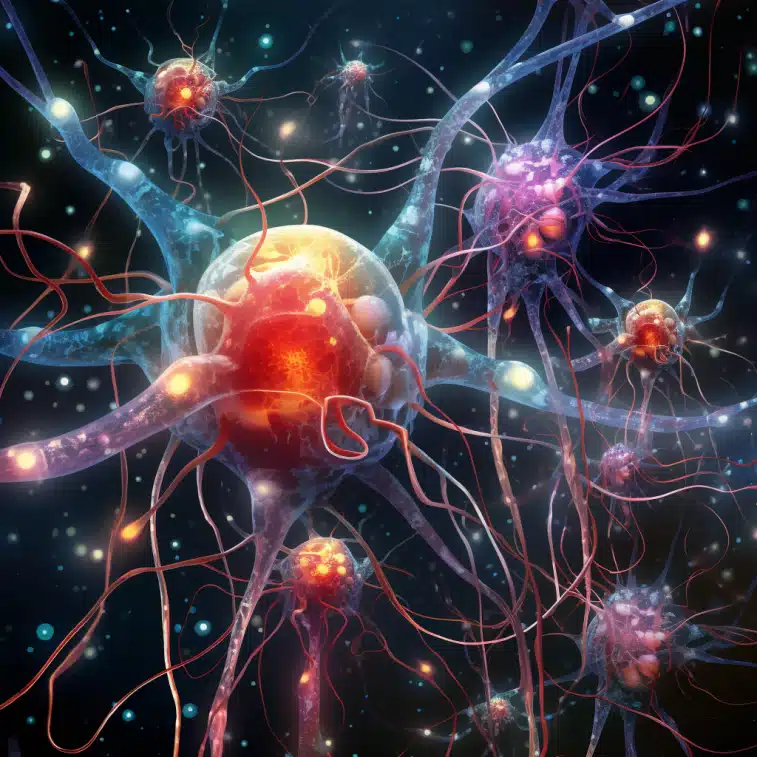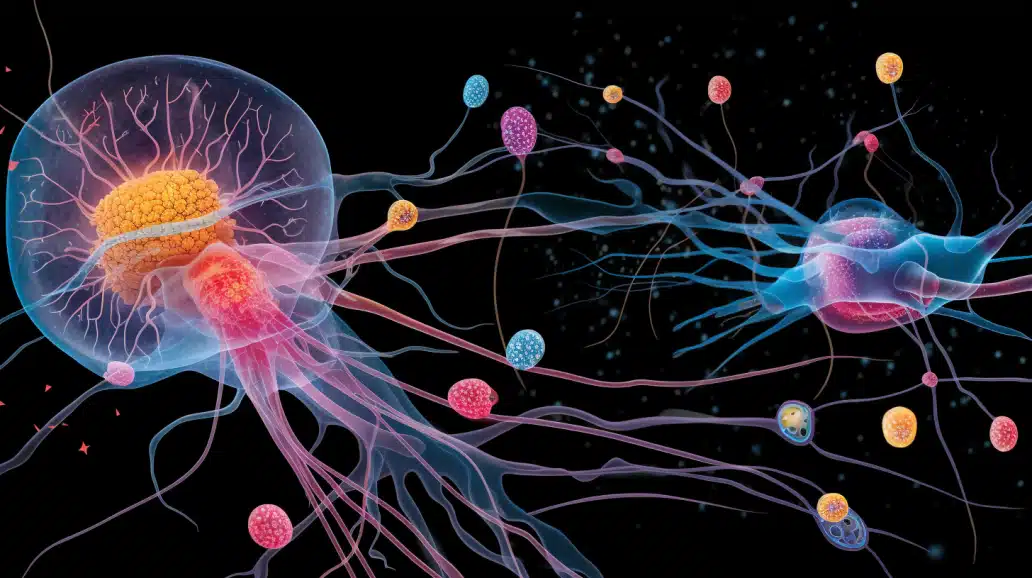Depression affects over 300 million people globally.
Current antidepressants have limited efficacy and slow onset of action.
New research shows promise for compounds targeting metabotropic glutamate receptors 2 and 3 (mGluR2/3) as fast-acting antidepressants with fewer side effects.
Key Facts:
- 1/3 of depressed patients are treatment-resistant with current antidepressants
- mGluR2/3 inhibitors show robust, rapid (within 1 day), sustained (over 1 week) antidepressant effects in rodent studies
- Some mGluR2/3 antagonists effective in antidepressant-resistant models
- Few side effects compared to ketamine; no psychotomimetic or abuse potential
- Mixed clinical trial results so far but further research warranted
Source: Cell Mol Neurobiol. (2023)
The Need for Better Antidepressants
Depression is a widespread chronic mental health disorder characterized by persistent low mood, loss of motivation, and other debilitating symptoms.
Current first-line medications including selective serotonin reuptake inhibitors (SSRIs) can take weeks to achieve a therapeutic response.
Additionally, at least 30% patients show inadequate responses, developing a treatment-resistant form of this disorder.
This underscores the need for faster acting antidepressants with efficacy in resistant populations.
The Glutamate Hypothesis of Depression
Converging evidence over the past two decades points strongly to the neurotransmitter glutamate and disruption of synaptic plasticity as contributors to depression pathophysiology.
The glutamate receptor modulator ketamine produces rapid (within hours) and robust antidepressant effects even in treatment resistant patients.
Unfortunately ketamine also induces psychotomimetic side effects and abuse liability.
These findings led researchers to explore alternative means of targeting the glutamate system for safer medications.
Metabotropic Glutamate Receptors: mGluR2/3 There are two classes of glutamate receptors:
- Ionotropic receptors (iGluRs), which mediate fast excitatory neurotransmission
- Metabotropic receptors (mGluRs), which modulate neural signaling through intracellular second messenger systems
mGluRs are further divided into groups I, II, and III.
Group II includes mGluR2 and mGluR3, which function mainly as presynaptic autoreceptors and heteroreceptors, inhibiting neurotransmitter release.
These receptors represent promising drug targets, as antagonizing them increases glutamate availability similar to ketamine but through a more targeted approach less likely to produce adverse effects.
mGluR2/3 Inhibitors: Robust Effects in Preclinical Studies
Several selective mGluR2/3 antagonists and negative allosteric modulators (inhibitors with non-competitive action) have shown antidepressant potential in animal studies.

Effects are summarized for some key examples:
- MGS0039: Antidepressant effects within 1 day, lasting over 1 week
- LY341495: Rapid and sustained antidepressant effects through increased mTOR signaling
- LY3020371: Ketamine-like antidepressant actions without side effects
- RO4491533: Reversed coping deficits in rodents, fast acting
- VU6010572: Rapid effects, efficacy in treatment resistant models
Proposed mechanisms underlying these antidepressant-like actions involve increased glutamate and monoamine neurotransmitter release, synaptic protein expression, activation of BDNF pathways, and restoration of synaptic plasticity.
Of note, certain mGluR2/3 inhibitors were effective in models insensitive to conventional antidepressants, suggesting potential utility for treatment resistant populations.
The rapid therapeutic time course mimicking ketamine represents a major advantage over current agents.
These robust preclinical findings provide a compelling rationale to test mGluR2/3 inhibitors for treating depression in human studies.
Clinical Studies: Mixed Results So Far with Glutamate Targeting
Several mGluR2/3 negative allosteric modulators advanced to clinical testing over the past decade.
Phase 1 trials generally demonstrated favorable safety and pharmacokinetics.
However, phase 2 studies failed to show efficacy for primary outcomes measures.
For example, RO4995819 did not separate from placebo in a 6 week trial of major depressive disorder.
And a phase 3 program evaluating this compound was ultimately discontinued.
Another agent, TS-161, is currently under investigation.
While current clinical results have been underwhelming, researchers propose various explanations including suboptimal drug properties, the complex multifaceted nature of depression, and lack of regional specificity in the brain.
The Path Forward: Optimizing mGluR2/3 Inhibitors for the Clinic
As seen, initial clinical disappointments with mGluR2/3 inhibitors contrast sharply with strong preclinical signals of efficacy.
Where do we go from here?
Below are several promising strategies to help bridge this efficacy gap moving forwards:
- Structure-based drug design: Creating agents with improved selectivity and pharmacological properties could enhance clinical effects. Structure-activity relationships should inform chemical modifications enhancing receptor affinity, drug-like character, and central nervous system penetration.
- Biomarker-driven studies: Objective neurophysiological biomarkers like EEG could help demonstrate target engagement and pharmacological activity in humans independent of subjective symptom assessments. Biomarker signals could guide dose selection and suggest potentially responsive patient subtypes.
- Novel drug delivery methods: Delivery innovations enhancing blood-brain barrier permeability and targeting specific neuroanatomic regions may improve effects. Nanotech carriers, prodrugs with enhanced uptake, and intranasal administration represent fruitful developments on the horizon.
- Precision medicine approaches: Genetic, imaging, and other techniques identifying probable “glutamate subtype” depression could enable clinical trials enriched with responsive patients. This strategy of right drug/right patient could unveil clinically meaningful effects not apparent in heterogeneous groups.
- Combination therapy: As monotherapies failed thus far and depression involves overlapping disruptions across multiple neurotransmitters (glutamate, monoamines, etc.), multi-target treatment regimens may achieve synergistic benefits.
In aggregate, while progressing selective mGluR2/3 inhibitors into bonafide clinical antidepressants proved more challenging than initial hopes suggested, sufficient promise remains to warrant revisiting this target with aid of the translational enhancement strategies delineated above.
The quest to develop rapid-acting antidepressants through modulation of glutamate holds promise in revolutionizing treatment of this devastating condition.
Evaluating New Approaches for Assessing Antidepressant Efficacy
Most failed Phase 2/3 antidepressant trials – across various drug classes including mGlu2/3 inhibitors– rely on subjective rating instruments often insensitive to rapid improvements
Outcome measures demanding sustained weeks-to-months treatment may inadequately capture effects of faster-acting drugs.
Even a single ketamine infusion can transiently ameliorate depressive symptoms for days, which such scales could overlook.
Alternative metrics better attuned to quickly emerging treatment responses merit consideration when judging future rapid-acting agents like mGluR2/3 inhibitors.
Some potential options include:
- Repeated daily symptom ratings
- Ecological momentary assessments via mobile devices
- Neurophysiological biomarkers: qEEG, fMRI, etc.
- Rapid response analyses: Early improvement predicting eventual outcomes
- Computerized tests of motivation, cognition, mood
Additionally, the concept of what constitutes meaningful “response” or “remission” may require rethinking for rapidly acting drugs, as holding them to the high bar of 6–8+ week trials designed for slow SSRIs appears illogical and may miss benefits.
For example, short term amelioration of suicidal thoughts could support certain agents’ use despite lacking months-long complete symptom abolition.
In closing, evaluating next wave rapid acting interventions calls for innovating how we conduct clinical trials – incorporating newer metrics attuned to early change trajectories and considering nuanced conceptions of treatment response coupled to short term but clinically valuable improvements in targeted symptom domains.
Future of mGluR2/3 inhibitors for depression
In summary, selective mGluR2/3 inhibitors continue to hold promise as next generation antidepressants based on robust preclinical data.
However, additional work remains to translate these findings into clinically viable therapeutics.
Strategies like combined treatment approaches, drugs with improved brain penetration, and compounds with enhanced specificity for depression circuitry could improve outcomes.
Although currently available agents failed to meet primary endpoints in trials, research should continue in this area given the immense unmet need and treatment limitations associated with this devastating, disabling condition affecting hundreds of millions globally.
References
- Study: Are mGluR2/3 inhibitors potential compounds for novel antidepressants?
- Authors: Yajie Jiang et al. (2023)







